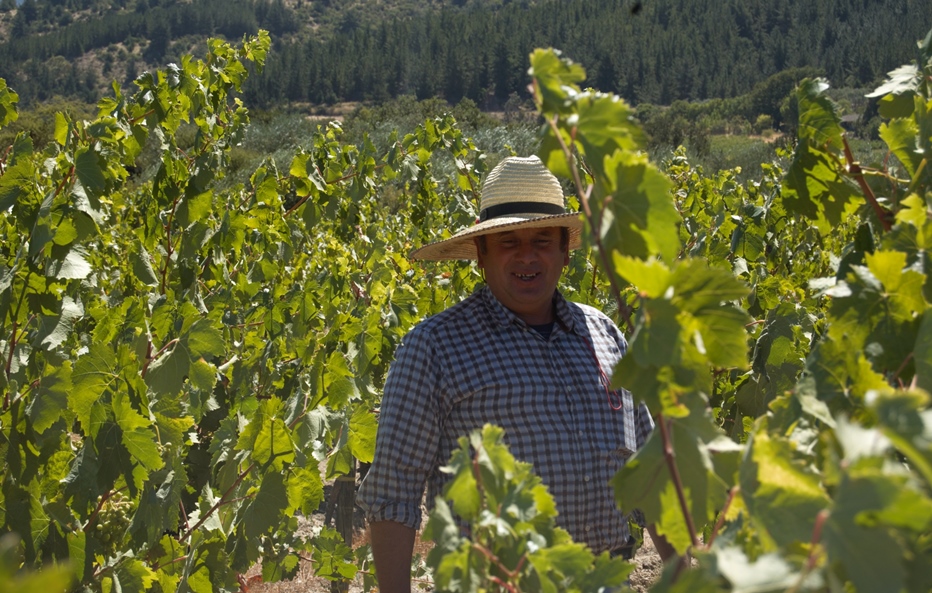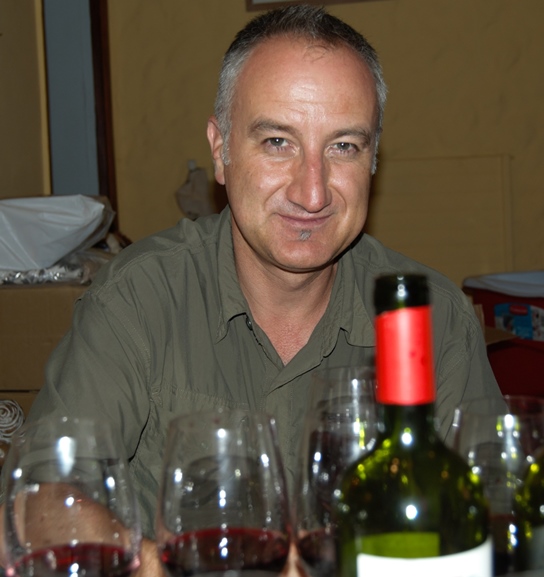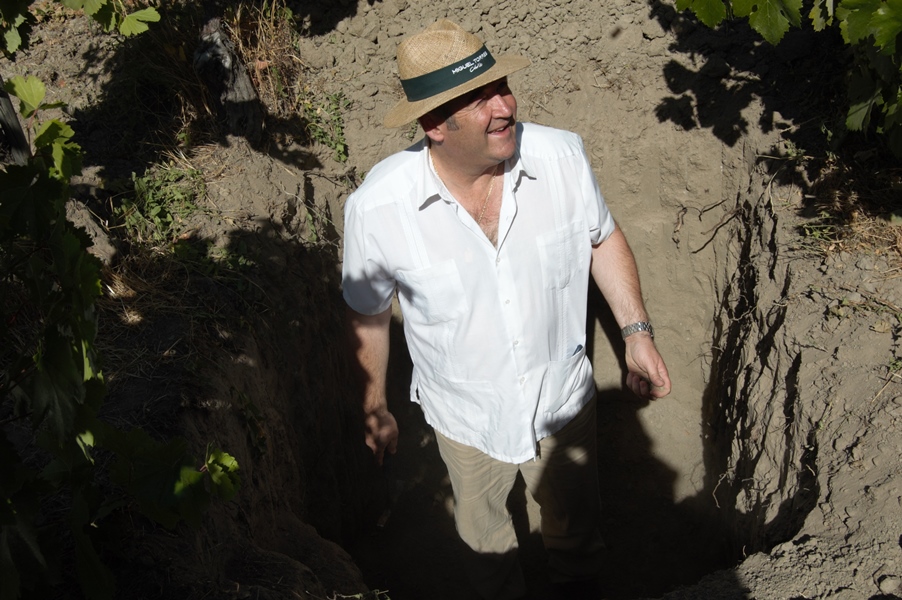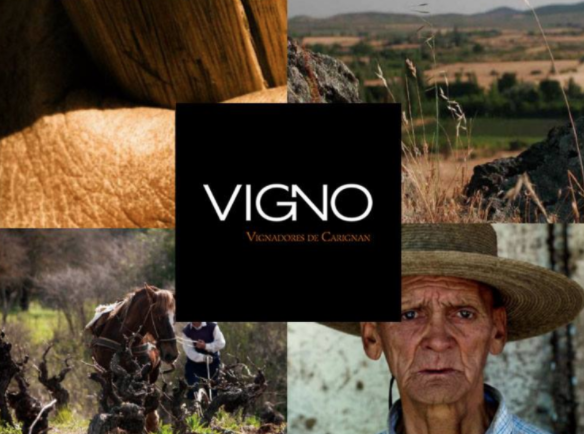What is Vigno?
Vigno stands for Vignadores de Carignan and is an association of producers whose goal is to create an appellation of origin for wines made from old Carignan vines that have been dry-farmed and bush-trained in the Maule Secano area.
Why was Vigno set up?
In understanding what is Vigno, you have to try to understand the place first. The Secano area of Maule is very dry and poor. Some 700mm-800mm of rain falls in winter, some of which is stored in the soils. However, beyond the water reserves in the soils, there is minimal additional water available for the rest of the year, which means that crops have needed to be able to get by without additional irrigation. Furthermore, the soils are of very poor quality with few nutrients. The only plants that have been able to cope with the poor soils and lack of irrigation during the growing season are olives and País and Carignan vines.

The vineyards and viticultural know-how have been passed down from generation to generation
For 400 or more years, the many small subsistence farmers in the area have eked a living from grapes and olives, and kept a few sheep or goats. Vineyards with old, low-yielding vines and traditional viticultural techniques have passed from one generation to another, but in recent decades the region has declined. For many years, Chile’s wine producers wanted high-yielding international varieties to produce the value-for-money wines that export markets demanded and so the price they were willing to pay for the traditional varieties like País and Carignan grapes went into freefall, reaching an unviable $100 pesos per kilo, insufficient for a family to live on. So, as older generations became too old to farm the land, the younger generations have progressively taken the decision to move to urban areas in search of a decent income and many vineyards have lain idle or been lost altogether. At this time, according to a study by the Universidad de Talca, there are some 110-120 small-scale producers of dry-farmed Carignan left in Maule Secano, with around 600 ha of Carignan vines.

Andrés Sánchez
It was in the 1990s that a number of producers, such as Gillmore, Miguel Torres and Odfjell realized that very interesting wines could be made from some of these low-yielding old vines, in particular Carignan. It was Andrés Sánchez, the winemaker at Gillmore winery who had the initial idea to set up an association with a view to safeguarding the remaining Carignan old-vine vineyards and the viticultural know-how of the local producers. He and journalist Eduardo Breithauer evangelized the idea among other wine producers and, after much discussion, Vigno was born in 2010.
Who is involved?
The current members are:
- De Martino
- Garage Wine
- Gillmore
- Lapostolle
- Meli
- Morandé
- Viña Roja (Bodegas RE)
- PS Garcia
- Valdivieso
- Bouchon
- Odfjell
- Ollé
- Undurraga
- Concha y Toro
- Alcance
Each member pays a monthly fee and has an equal vote. There is a committee, which is elected by the members.
If a winery wants to join Vigno, the existing members visit the vineyard and taste the wine to be sure that the winery meets the criteria. You can read the producer profiles below!
What are the rules for being able to label a wine Vigno?
The wine must meet the following characteristics:
- The grapes must be from dry-farmed, gobelet or bush trained vines that are at least 30 years old and located in the area known as Maule Secano;
- 70% or more of the blend must be Carignan (this has just changed from 65%); the other grapes must meet the same criteria as the Carignan grapes;
- The wine must be aged for a minimum of two years.

Vertical tasting of Vigno wine by De Martino
The word “Vigno” with its defined font must be prominent on the label, as shown in the photo above. The label cannot include the terms “Reserva” or “Gran Reserva” but it can say “Old Vines” and/or “Dry-farmed”.
What has Vigno achieved?
Better grape prices
The grapes that qualify for use in Vigno have recently become some of the most highly priced wine grapes in Chile, reaching USD1 or even 1.50 per kilo (from an unviable low price of around 10 US cents a decade ago).
A shared brand
Vigno producers have developed a brand, which they use on the label of their products, alongside their own corporate branding and they have shared marketing campaigns, including a Vigno website, a brochure and a Vigno stand at wine fairs. Given that these are necessarily small-scale productions, joining forces for marketing makes financial sense and helps create a stronger image internationally.

Miguel Torres winemaker Fernando Almeda in their Vigno Carignan vineyard in Maule
Terroir study
The Universidad de Talca recently carried out a very detailed study, with 24 test pits at different Carignan vineyards across Maule Secano, such as the one in the photo above at Miguel Torres’ Santa Rosa vineyard. The study recorded detailed information about the soil and weather data over time. The project also involved making wine from grapes grown at each of the 24 sites, using exactly the same winemaking techniques. The resulting wine was subject to a range of analyses to see how it differed in terms of amino acids, phenols, volatile compounds etc.
The results of this study have been put into a detailed map of terroir.
What are the plans for the future?
Certification of vineyards
Wine producers need to show the origin of the grapes that they use, so they require certification of origin from the grape producer. So when a vineyard needs to get certification for its grapes, it pays a small fee of around $1 to $1.5 pesos per kilo of grapes to get this from one of the organizations that has been recognized by the agricultural authority (SAG) for this purpose. The Vigno association is looking into the idea of providing additional private certification for those vineyards producing grapes suitable for Vigno using the same system. This would give those growers additional prestige and help them command a better price for their grapes.
Producer Profiles: Vigno wine producers
De Martino
This winery was set up by an Italian family in 1934 based in Isla de Maipo, near Santiago. The current generation seeks to make wines that reflect their origin, sourcing grapes from specific plots of land in different parts of Chile.
De Martino works with two vineyards in Maule, both in the Coastal Mountain Range. Its Vigno wines are made from grapes from the La Aguada vineyard, which was planted in 1955 and has mainly Carignan vines, interplanted with other red varieties. The soils are granitic in origin and yields very low.
Winemaker Eduardo Jordán explained that they are now harvesting their Carignan grapes about a month earlier than they used to, to ensure that the grapes are healthy and that the wines are fresh, with vibrant fruit expression, and fermenting with native yeasts. He says that their philosophy is to do the work in the vineyard and then the winemaker’s job is ‘not to mess it up’. They seek to make wines with minimal intervention.
De Martino’s Vigno 2015 is a field blend, with 85-90% Carignan and 10-15% Malbec, Cinsault, Cabernet Sauvignon & Carmenère. The wine was aged for 36 months in 500-litre foudres.
–
Garage Wine Co.
Garage Wine began in Pilar and Derek Mossman’s garage in 2001, when they made wine to enjoy with friends. Production grew and the firm now makes small lots of red wines, particularly a series of Carignan field blends, from small parcels of old vines that belong to separate small growers or vignerons whose families have been working these old vines by hand and horse for centuries.
The wine from each vineyard is made and bottled separately. The fruit is fermented using open-top fermenters using native yeasts and the caps are punched down by hand. Pressing is manual. Wines are barrel aged for two winters. Malolactic fermentation occurs slowly and naturally over the cold winter months. Generally, the wines spend a full year in bottle before release. Sulphites are added sparingly before bottling.
Garage Wine’s Vigno 2014 is 90% Carignan, 10% Mourvèdre. It was aged for two winters in neutral oak and one winter in bottle.
–
Gillmore Wines
Gillmore is a family business, founded in the Loncomilla Valley in Maule in 1990 by Francisco Gillmore. The Tabontinaja Vineyards are now managed by his daughter Daniella and son-in-law, winemaker Andrés Sánchez, the founder of Vigno.
The family grows a range of varieties, including Carignan. They are all grafted onto century-old País vine rootstock which contributes to the character and terroir. The vineyard has terraces made up of alluvial clay soils and deep granitic colluvial rocks accommodate deep root systems without excessive fertility. The gently rolling hills with gradients of 5 to 8% ensure good drainage. This combination results in a low yield of distinctive fruit.
Gillmore’s Vigno 2014 is 100% Carignan. The wine was aged for 18 months in neutral French oak barrels. Unfiltered and bottled on the property.
–
Lapostolle
Lapostolle was originally founded by the Marnier Lapostolle family (Alexandra Marnier Lapostolle and her husband Cyril de Bournet) from France and the Rabat family (Don José Rabat Gorchs) from Chile in 1994. The biodynamic winery is based in Apalta, Colchagua with a strong emphasis on producing high-quality wines with French flying winemaker Michel Rolland as the consultant for Lapostolle’s classic wines.
Lapostolle’s Vigno wine is part of a separate collection of small-production wines from vineyards around Chile and made by winemaker Andrea Leon. For the Vigno wine, she sources the Carignan from vineyards in Truquilemu/Empedrado where wild flowers grow alongside the vines. The wild flowers including chamomile and other aromatic herbs and it is thought that they aid the herbal note which is especially apparent in wines from here.
Lapostolle’s Vigno 2015 is 100% Carignan, the grapes being vinified with native yeasts. The wine was aged for 15 months in 3rd-use French oak barrels and has been neither fined nor filtered.
–
Meli
Meli is the dream of winemakers Adriana Cerda and her son Eduardo. Adriana was a respected winemaker for 30 years when she decided it was time to make her own wine.
In 2005, she and her three adult sons bought a property with 60-year-old Carignan and Riesling vines in Loncomilla in the Maule Valley. They make wines from dry-farmed Riesling and Carignan vines (the latter 60 years’ old), both varieties that are well-suited to the Maule Valle, where the growing season is long with cool nights and warm days. The wines are made with ambient yeasts, natural acidity and little use of oak.
Meli’s Vigno 2014 is 100% Carignan, made with native yeasts. It was aged without wood, in small vessels.
–
Morandé
Originally founded by winemaker Pablo Morandé in 1996, the company was acquired by Empresas Juan Yarur in 2000, who set up Grupo Belén which now owns the company. Morandé prides itself on its pioneering spirit, including its production of old-vine Carignan from Maule.
Morandé buys Carignan grapes from a vineyard in the Melozal area in the coastal mountain range of Maule Secano, which was planted in the early 1950s with Carignan, Pais and Sémillon. Some vines were grafted with Grenache and Syrah. Vineyards are east-facing with the Carignan being bush- or gobelet-trained and dry-farmed. The vines are planted in very poor granitic-clay soils.
Morandé’s Vigno 2015 is 78% Carignan 18% Syrah, 4% Chardonnay. The wine was matured for 20 months in French Oak barrels: 25% new and the rest 3rd and 4rd use.
–
Miguel Torres Chile
Miguel Torres is a family business founded in Spain in 1870. It set up operations in Chile in 1979 and is well-known for its organic and fair trade credentials.
Miguel Torres Chile acquired two vineyard areas in Huerta del Maule in Maule Secano in 2007 and has extended them so it now has 187 hectares of land, of which 20.47 are planted with vines. Old-vine Carignan is of particular priority in these vineyards. The soils at the Huerta de Maule site are sandier, resulting in lighter, steelier wines with good acidity, while those at Santa Rosa have a higher clay content, giving the wines more structure and vigour. The land is worked with horses, who plough up the weeds and grass in spring.
Miguel Torres’ Vigno 2014 is 100% Carignan. The wine was aged for 12 months in French oak (30% new oak and 70% second use).
–
Viña Roja
This wine is part of Bodegas RE, the personal family winery of Pablo Morandé and his son Pablo Morandé Jnr. The Morandé family bought Viña Roja in early 2000, with a view to rescuing the old Carignan vines and other old vines that could be grafted.
It is a mature vineyard over 60 years old, is located in the central part of the Maule mountains. The soil is red clay generated by the degradation of granite and is low in fertility. It’s a dry-farmed vineyard with bush-trained vines that have low yields.
Viña Roja’s Vigno 2010 is 100% Carignan. It was aged for 12 months in American oak barrels from La Rioja.
–
PS Garcia
Felipe Garcia is an independent winemaker seeking to make distinctive wines from grapes from the Casablanca, Maule and Itata regions. Felipe sources his Carignan grapes from a vineyard with 55-year old vines in Melozal.
Garcia + Schwaderer’s Vigno 2014 is 100% Carignan. It was aged for 21 months in French Oak barrels. (PS Garcia was formerly Garcia & Schwaderer)
–
Valdivieso
In 1879, Alberto Valdivieso set up Champagne Valdivieso, becoming the first sparkling wine producer in South America and it is for its sparkling wines that Valdivieso continues to be best known. However, in addition to its sparkling wine plant in Macul, near Santiago, Valdivieso now also has a winery in the Curicó area and produces a broad range of still wines, including Éclat Vigno.
Valdivieso sources its Carignan grapes from a vineyard in Melozal.
Valdivieso’s Vigno 2010 is made from 66% Carignan, 34% Mouvèdre. The grapes were fermented in 5-tonne open top fermenters. The wine was aged in French oak barriques for 12 months.
–
Bouchon
Bouchon was founded by a French winemaker who arrived in France in 1887. The company is now being managed by the third and fourth generation of the family and produces a wide range of wines, including some innovative bottlings of old vine Semillon and Pais. The winery is wholly based in Maule, where it has three vineyards. The company sources the grapes for Vigno from a vineyard in Melozal with decomposed granite soils with a medium level of clay.
Bouchon’s Vigno 2015 is made from 100% Carignan. The fermentation took place with ambient yeasts. The wine was aged for 12 months in foudres and for a further 12 months in the bottle.
–
Odfjell Vineyards
The Odfjell winery was set up in the Maipo Valley some 25 years ago by Norwegian shipping magnate Dan Odfjell and is now managed by his sons with French winemaker Arnaud Hereu leading the oenology team. The company has three vineyards and uses its own grapes in its wines. It is committed to sustainability; all its vineyards and grapes are certified organic and the company has now adopted biodynamic practices.
The grapes for Vigno are from their “Tres Esquinas” vineyard in Cauquenes, which is certified biodynamic. The soils here are deep and poor with a good level of clay. The vines are 100 years old and dry-farmed.
Odfjell’s Vigno 2014 is made from 100% Carignan. The wine was aged for 18 months in new French oak barrels.
–
Ollé
Ollé is the owner of a large vineyard, who has been selling grapes to several wineries to make Vigno for a number of years (and continues to do so). Ollé has now become a member of Vigno in his own right and is currently vinified his own wine, set to be released in the near future.
–
Undurraga
Undurraga was set up by Francisco Undurraga in the late 19th century but passed out of family hands in 2005. It is a well-established company with 1,350 hectares of vineyards and substantial winery facilities and makes a very wide range of still and sparkling wines.
There are several winemakers in Undurraga’s team, however Vigno is the domain of winemaker Rafael Urrejola who is also responsible for the winery’s Terroir Hunter collection. The grapes for Vigno are sourced from a vineyard in Sauzal, that was planted in 1958 and has a granitic soil.
Undurraga’s Vigno 2014 is made from 86% Carignan, 14% Cinsault. The grapes were fermented with their native yeasts. The wine was aged for 18 months, 10% in new oak.
–
Concha y Toro
Founded in Chile in 1883, Viña Concha y Toro has become the largest wine company in Latin America and the fifth largest company in the world in terms of market volume and second-largest in planted vineyards.
Concha y Toro sources the grapes for Vigno from the Patillo and Los Postes vineyards to the south east of Cauquenes, 30 kilometres from the coast. These are old, head-trained vines, with a warm, inland climate.
Concha y Toro Vigno 2014 is made from 100% Carignan grapes. 10% of the grapes were vinified using carbonic maceration.
–
Alcance
Jackson Family Wines, one of the world’s largest wine companies, bought two estates totalling around 200 ha in Maule in 1993 under the name Alcance. The El Maiten Vineyard is situated at the base of the Andes Mountains. Its climate is arid and mild and its wines are broad shouldered with strong aromatics and round tannins. The San Francisco Vineyard is southwest of Maule. The most striking feature of this site is its soil — the ground is thick with quartz crystals. San Francisco’s wines are tightly wound and precise with high-toned aromatics and firm flavours.
All of the fruit for Alcance comes from mature blocks farmed for low yields. After hand sorting, the fruit is fermented in small lots to preserve the essence of the terroir and provide more options when creating final blends. Under the supervision of Chilean Winemaker Andrés Sanchez and American Winemaster Randy Ullom, Alcance produces Cabernet Sauvignon, Merlot, Carmenère, Vigno (old-vine Carignan) and Bravura, the winery’s flagship Bordeaux blend. Most Alcance wine is sold in the US.
Alcance Vigno 2015 is 100% Carignan. It was aged for 18 months in used oak and bottled unfiltered.
What is Vigno? Andrès Sànchez interview
We asked Vigno member and founder Andrés Sánchez what is Vigno, what does the association stand for and where it is going in the future:
What is Vigno? Andres Sanchez interview transcript for hearing impaired
So Andres, can you tell me what is Vigno?
So Vigno is an association of a group of people that we are working together in order to rescue of old vine Carignan. in order to save a kind of culture that we have in the south part of Chile. This is what it’s all about it.
When you started with some other producers of Carignan here in Maule, what were the main goals? To rescue these vineyards and create a category?
Yeah, you know we start to work together with a group of 12, 13 members. Most of them are winemakers and we shared a passion to for these old vines of Carignan. We believe the great potential of the wine made it by Carignan, so we decided to create a kind of association We created some rules. If you want to be part of this association you need to produce wine with a very old Carignan vines, a minimum 30 years old but most of them are 60 and 70 years old, they need to be in dry farming (no irrigation), they need to be in a head pruned and in the wine we also we need to not release the wine two years before we made it, and as a minimum it needs to be 70% Carignan in the wine.
And how is this change for Chile? How is this new to Chile?
I think it’s a, like I always said, it’s a jump to the moon for the Chilean wine industry. It was the first time that a group of wine producers create a statement of quality, because if you need to use old vines from one specific area and dry farmed, and head pruned, with two years before the release and with the 70% as a minimum [Carignan], we are really making a statement about the quality. That and also with using the image, common image. so everybody needs to use Vigno (Vignadores de Carignan) in a more important way than their own brand. So it’s kind of, I will say, it’s probably the first real appellation in Chile. We have a DO (Denomination of Origin) in Chile so but the DO works as a geographic indication basically, without any statement of quality. So this is the first time that it has happened.
What is it here in Maule (where you live with your family) that’s worth protecting? What is the heritage that you’re trying to protect?
I mean, people know Chile and know specifically the central part of Chile, but when they are thinking in viticulture but if you have the chance to come to this area you will find you know the culture that the Spanish brought 500 years ago especially within the vines, you can see a lot of the old vines in dry farming, cultivated head pruned and this is a heritage from the Spanish. It’s a treasure.
More on Vigno Carignan and Maule:
- Vigno coming of age
- Carignan Profile
- Live wine tasting with Andres Sanchez and Fernando Almeda
- Maule and the Carignan boom
- Maule wine region guide and Fast Facts
- The diversity of Maule terroir

